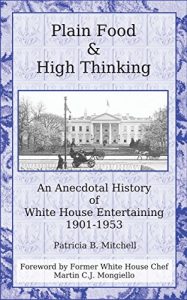An overview of food and entertaining in the White House, 1901–1953. Authored by Patricia B. Mitchell. Edited by Sarah E. Mitchell. Foreword by former White House chef Martin C.J. Mongiello. Published 2005. 25 recipes, 142 research notes, 12,863 words.
Writer Gilson Willets in 1908 used the words “plain food and high thinking” to describe the philosophy of Theodore Roosevelt. Patricia B. Mitchell chose his phrase to be the title of her book about White House entertaining under the eight administrations between 1901 and 1953. (Earlier administrations are covered in Mitchell's companion White House books "That Palace in Washington: An Anecdotal History of White House Entertaining 1800–1850" and "Delicacies in Proportion: An Anecdotal History of White House Entertaining 1850–1901.".
Gossipy stories, quirky food preferences, anecdotes, and recipes enliven the text of Plain Food & High Thinking. Quotations such as FDR's comment about “chicken six times in a single week” reveal that affairs of the plate were sometimes as much a concern, at least momentarily, as affairs of state.
In a theme repeating itself throughout White House history, Calvin Coolidge revealed his envy of his servants' food — specifically, their big griddle cakes in contrast to his dainty ones.
The copious endnotes in "Plain Food & High Thinking" are useful to scholars and anyone interested in additional worthwhile reading and research.
Featured in the book are: Theodore and Edith Roosevelt; William and Helen Taft; Woodrow and Ellen (died 1914) and Edith Wilson; Warren and Florence Harding; Calvin and Grace Coolidge; Herbert and Lou Hoover; Franklin and Eleanor Roosevelt; and Harry and Bess Truman.
This and other books by Patricia B. Mitchell were first written for museums and their patrons, and are now available as Kindle editions. Each of her books summarizes a food history topic, using quotations and anecdotes from early sources to both entertain and inform. She carefully lists her references to make it easy for others to launch their own research.
Since the 1980's Patricia Mitchell's work is a proven staple of American museum culture. Her readers love to share her ever-present sense of discovery. Her sales are approaching a million copies, and she is widely known by her web identity FoodHistory.com.
Writer Gilson Willets in 1908 used the words “plain food and high thinking” to describe the philosophy of Theodore Roosevelt. Patricia B. Mitchell chose his phrase to be the title of her book about White House entertaining under the eight administrations between 1901 and 1953. (Earlier administrations are covered in Mitchell's companion White House books "That Palace in Washington: An Anecdotal History of White House Entertaining 1800–1850" and "Delicacies in Proportion: An Anecdotal History of White House Entertaining 1850–1901.".
Gossipy stories, quirky food preferences, anecdotes, and recipes enliven the text of Plain Food & High Thinking. Quotations such as FDR's comment about “chicken six times in a single week” reveal that affairs of the plate were sometimes as much a concern, at least momentarily, as affairs of state.
In a theme repeating itself throughout White House history, Calvin Coolidge revealed his envy of his servants' food — specifically, their big griddle cakes in contrast to his dainty ones.
The copious endnotes in "Plain Food & High Thinking" are useful to scholars and anyone interested in additional worthwhile reading and research.
Featured in the book are: Theodore and Edith Roosevelt; William and Helen Taft; Woodrow and Ellen (died 1914) and Edith Wilson; Warren and Florence Harding; Calvin and Grace Coolidge; Herbert and Lou Hoover; Franklin and Eleanor Roosevelt; and Harry and Bess Truman.
This and other books by Patricia B. Mitchell were first written for museums and their patrons, and are now available as Kindle editions. Each of her books summarizes a food history topic, using quotations and anecdotes from early sources to both entertain and inform. She carefully lists her references to make it easy for others to launch their own research.
Since the 1980's Patricia Mitchell's work is a proven staple of American museum culture. Her readers love to share her ever-present sense of discovery. Her sales are approaching a million copies, and she is widely known by her web identity FoodHistory.com.






